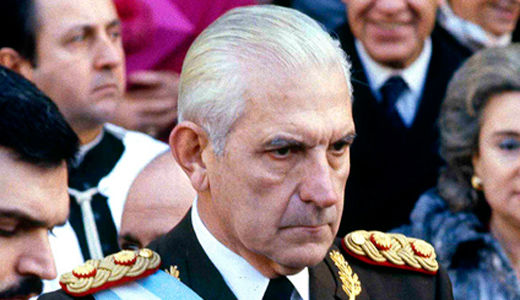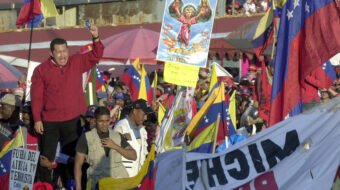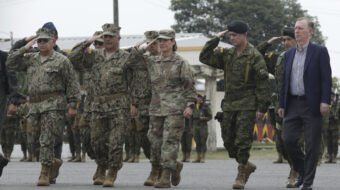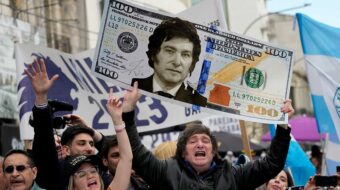
On May 27, an Argentine court in Buenos Aires convicted 14 military officers of conspiring to commit, and of committing crimes against humanity during the country’s “Dirty War” of 1976 to 1983. This was a long trial, and a number of aging defendants died before its conclusion. There have been other trials and convictions before, but this one included high ranking officers – 13 Argentines and an Uruguayan-whose victims were not just Argentine citizens, but those of other countries targeted under a regionally coordinated plan called “Operation Condor.”
The United States is also implicated in this bloodthirsty program, in which hundreds of dissidents may have been murdered. Overall, perhaps 60,000 people were murdered by right-wing governments in South American countries during this period.
The star defendant in the trial was General Reynaldo Bignone, who was the last president of Argentina under the dictatorship which took power in 1976 in a coup against President Isabel Perón, and called itself the “Process of National Reorganization.” Bignone was already serving time for crimes against humanity when convicted in this current trial.
Another defendant was Major General Santiago Omar Riveros, who was especially involved in stealing the babies of captives who were about to be killed and distributing them to pro-government military officers. In 2009, General Riveros had been convicted of the murder of a 15-year-old member of Argentina’s Communist Youth League. The rest of the convicted persons were all military officers. Two other persons were found not guilty. Bignone and Riveros were sentenced to 20 and 25 years, respectively.
A coordinated campaign of state terror
Operation Condor was a coordinated plan of right-wing Latin American military and civilian-military dictatorships which was conceptualized in the late 1960s and given a more specific form in 1975, but it really took off after the Argentine coup of 1976. Earlier, political dissidents, leftists, trade unionists, and other people from Brazil, Chile, Paraguay, Uruguay, and Bolivia had fled to Argentina to seek safety from the official and unofficial death squads in their own countries, so Argentina was a key player in tracking down, “disappearing,” and killing people of several nationalities.
Some were assassinated on the streets of Buenos Aires, while others were tracked down and killed in places as far away as Italy and the United States. In many cases, the victims of this repression were kidnapped, taken to military installations where they were subjected to barbaric torture, then placed in military aircraft and flown out over the estuary of the Río de la Plata and dropped into the sea from a great height. That something like this was going on became known when dead bodies with hands and feet tied began to wash up on Argentina’s beaches.
The Argentine military collaborated with a right-wing death squad, the AAA or Argentine Anticommunist Alliance, as well as with European, especially Italian fascists. There are indications that Nazi war criminal Klaus Barbie, the “butcher of Lyon”, helped the government of Bolivian dictator Hugo Banzer to develop torture techniques.
Well-known pubic figures who were murdered by Operation Condor include former Bolivian President Juan José Torres, who had instituted leftist policies in his country; former Chilean army commander General Carlos Prats (and his wife) who had refused to back General Pinochet’s coup in Chile in 1973; former Brazilian President João Goulart, overthrown by the military in 1964; two Cuban diplomats; and a number of others.
One person whose murder caused some headaches to the Chilean dictatorship was Orlando Letelier, a former member of the cabinet of Chile’s socialist president, Salvador Allende, and former Chilean ambassador to the United States. Letelier and a U.S. assistant, Ronni Moffitt, were killed by a car bomb on September 21, 1976. The incident happened right on Sheridan Circle in Washington D.C. in the middle of “Embassy Row.” The negative reaction to this incident in the United States led to worry among the dictators that they would lose U.S. support, but during the Reagan administration similar things were done with the United States’ blessing in Central America.
After General Bignone was forced out of power amid a collapsing economy in 1983, the democratically-elected president who succeeded him, Raúl Alfonsín, was successfully pressured by the military to declare an amnesty for people accused of human rights violations. But in 2005, left-wing President Nestor Kirchner succeeded in getting the Argentine Supreme Court to rule that this amnesty was unconstitutional, and the trials began anew.
U.S. complicity for Condor crimes
To what extent were U.S. officials, and the U.S. government, complicit in some of these acts of terrorism? The worst actions happened during the presidencies of Richard Nixon and Gerald Ford; the pace picked up again during the Reagan administration.
A number of people involved in the Operation Condor atrocities had been on the Central Intelligence Agency payroll at one time or another. Others had received training at the U.S. Army School of the Americas. Some of this training included “counterinsurgency techniques,” which included how to use torture in interrogations. Relatively early in the cycle of mayhem, Uruguayan revolutionaries had captured and subsequently executed a U.S. agent, Dan Mitrione, who had been sent down to give torture courses first to the Brazilian and then to the Uruguayan security forces.
Much of the information that was used by Argentine prosecutors came from a stash of documents found in Paraguay, and yet more from the work of the National Security Archive, a non-profit research facility based at George Washington University in Washington D.C. Last year, U.S. Secretary of State John Kerry handed over some incriminating U.S. files dealing with the Letelier-Moffitt murder to Chilean President Michelle Bachelet. President Obama has promised to declassify more such files in the future.
From all of this mountain of information, investigators-academic, journalistic, and others-are trying to find out how far up in the U.S. government knowledge and complicity in the Operation Condor murders and other crimes went.
Questions are being asked about the role of Henry Kissinger, who was secretary of state under Nixon and Ford, when some of the worst incidents occurred, including the Letelier-Moffitt assassination. It seems clear that Kissinger had knowledge of some of the violence and indicated to the Argentine dictatorship that the United States would not interfere to stop it. “If there are things to be done, you should do them quickly. But you must get back quickly to normal procedures,” Kissinger is quoted saying in a June 1976 conversation with Argentine Foreign Minister Admiral César Guzzetti. This caused consternation at the U.S. embassy in Buenos Aires, but the State Department made light of the matter.
Kissinger is wanted for questioning on these matters in a number of countries, but has not cooperated with any investigation. He has to be careful about traveling abroad lest he be detained.
Another figure involved in some of the Operation Condor atrocities is Cuban exile Luis Posada Carriles, a former C.I.A. asset who may have been present for the planning of the Letelier-Moffitt murder, was involved in the bombing of a Cuban civilian airliner in 1976, and now is living out his life in Miami where he is lionized by right-wing politicians.
Argentina now has a new right-wing government, headed by President Mauricio Macri. He has reversed many progressive policies of his predecessors, and voices are being heard on the right calling for an end to the prosecutions of the perpetrators of the “Dirty War.” How Macri will react remains to be seen.
The watchword should be “never again.”
Photo: In this July 9, 1982 file photo, Argentina’s ex-dictator, General Reynaldo Bignone, arrives for a religious ceremony at the Cathedral in Buenos Aires. AP file

MOST POPULAR TODAY


Zionist organizations leading campaign to stop ceasefire resolutions in D.C. area

High Court essentially bans demonstrations, freedom of assembly in Deep South

Afghanistan’s socialist years: The promising future killed off by U.S. imperialism

Communist Karol Cariola elected president of Chile’s legislature






Comments